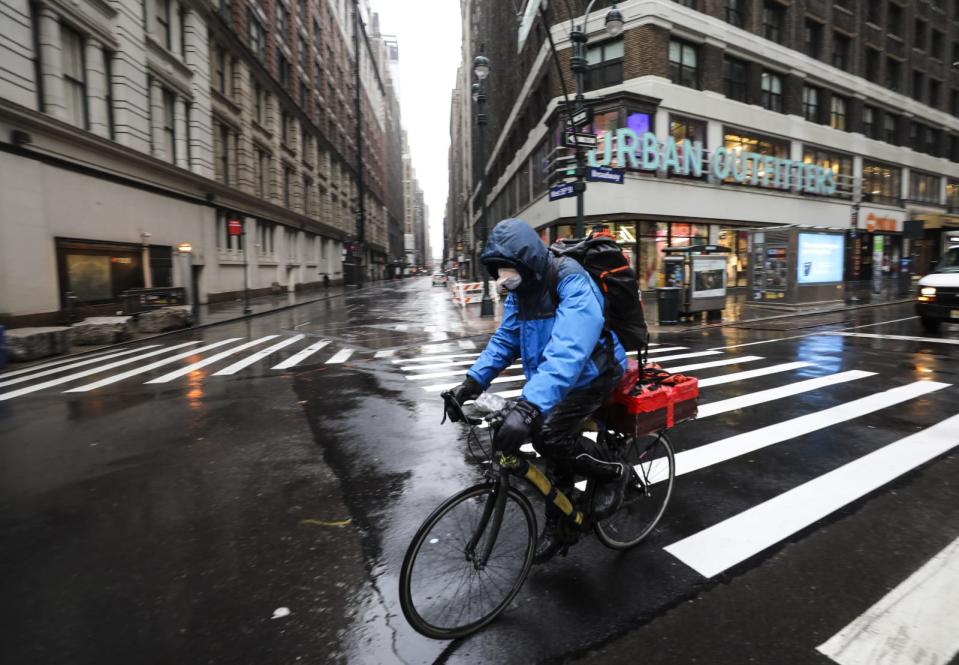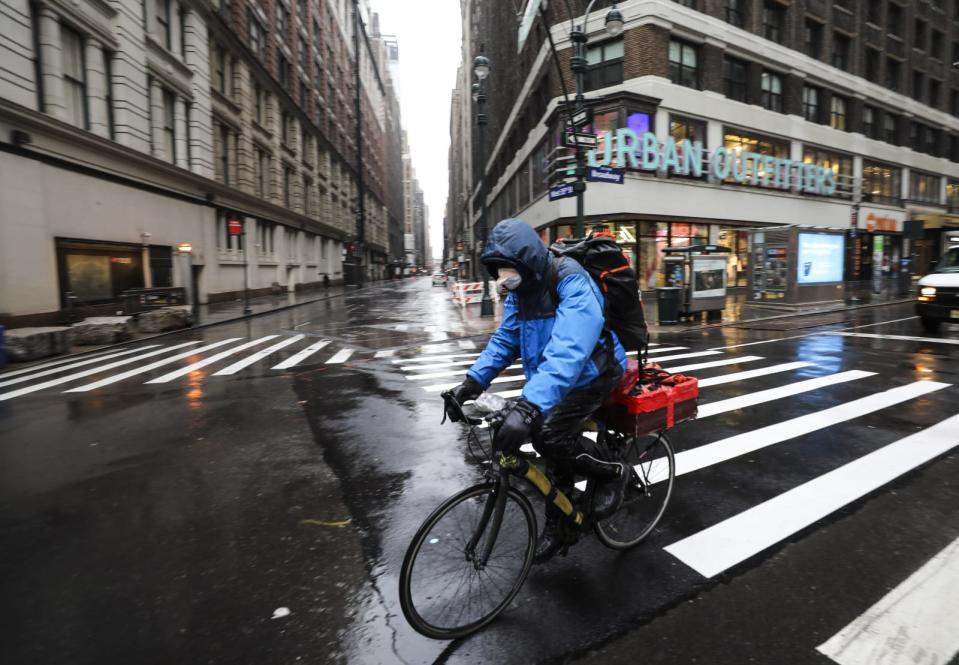Food delivery apps, the pandemic and finding a new normal
How to eat safely during a public health emergency.
Like the rest of the world, because of the coronavirus outbreak, the restaurant industry is in the midst of a serious reckoning.
As of writing, 23 American states have shut down restaurants except for takeout and delivery. In the UK, McDonald's has completely closed every location, including takeout and delivery. Despite campaigns like Tuesday's nationwide hashtag #thegreatamericantakeout, urging consumers to order takeout from local restaurants, many are shuttering for good. Even delivery logistics are proving a challenge, as illustrated by the large, non-socially distanced crowds assembled outside of Carbone in New York City, waiting for comfort food to go.
The result is that many of us -- restaurants and consumers alike -- are now relying on third-party delivery services like GrubHub and Caviar, which are changing their practices to accommodate the new normal.
DoorDash, which also owns Caviar, has implemented no-contact delivery: Delivery people pick up and drop off packages without interacting face to face with either restaurant workers or customers, by, for example, having them grab prepared bags from a designated table, text customers when they arrive and leave food on a doorstep. The company has detailed information on their websites about best practices for merchants and delivery people. Both services are offering two weeks of paid sick leave to delivery people who are ill or who have been quarantined. Significantly, the company is also waiving commissions for 30 days for independent restaurants new to the app and for pickup orders for existing merchants.
UberEats hasn't gone quite as far, but will compensate delivery people affected by COVID-19 for two weeks. On its site, it lists a variety of ways it's making Uber and UberEats safer, including having drivers clean their cars regularly and asking those with COVID-19 to self-isolate. As far as food delivery goes, the company has waived the delivery fee for independent restaurants and rather than instituting contactless delivery company-wide, simply offers an option in the app to have the delivery person leave your food at the door.
Seamless and its parent company, GrubHub, have also instituted contactless delivery. GrubHub is offering two weeks' support pay to drivers affected by COVID-19, and it has also created a Community Relief Fund, funneling all Donate the Change contributions to charities supporting restaurants and drivers affected by the virus. The company also announced it's deferring $100 million in commission fees for independent restaurants and is "matching all promotions run by independent restaurants" using its Smart Promotions feature.
In uncertain times, should delivery even be an option?
Still, there is a wider concern which goes beyond the powers of a delivery platform: Researchers are unsure of how long COVID-19 lives on surfaces like paper, cardboard and plastic, all of which are used in food delivery. What should us hungry customers stuck at home be thinking about when we order from restaurants? In uncertain times, should delivery even be an option?
The CDC has said that there isn't any evidence the virus is being spread through packaging or food itself, but Vaughn Tan, a qualitative sociologist at University College London who studies restaurants and uncertainty, thinks we still need to reevaluate our methods. We "need to simply be much more prudential than probably is necessary," advised Tan, who expects this situation to last for up to 18 more months. Working with scientists like Jennifer Gardy, the Deputy Director of Surveillance, Data and Epidemiology at the Gates Foundation, he's put together a best practices guide for the food and beverage industry.
For example, if you're ordering food from a restaurant, go as contactless as possible, from actual payments to tips to having the delivery person leave the food on your doorstep or in your lobby rather than handing it directly to you. Once you've received your food, immediately transfer it from the to-go container on to a clean plate or other container, then dispose of the to-go materials straight away, including any bags. Heat the food for a few minutes to further decontaminate it. Be sure to wash your hands for 20 seconds between each step. "Wash hands, open the container, reheat, wash hands again," advised Tan.
In other words, we should treat outside containers as if they are contaminated. Rick Camac, Dean of Restaurant and Hospitality Management at the Institute of Culinary Education, agrees. He said pickup and delivery using third-party apps are safe "but their approach to carrying packages and engaging customers has to change."
"Just like a restaurant kitchen, bathroom and/or dining room, extra sanitary precautions need to be taken with delivery. Everything from handling to delivery itself needs to be rethought," Camac said to Engadget in an email. "For instance, did the Uber Eats driver just drop off a passenger right before picking up your delivery package? In this case, is the car sanitized in between? Is food always held in the trunk? If so, what is being done to control temperature (a truck could be extremely hot or cold)?"
"I don't believe [third-party delivery services] can guarantee anything."
This exposes a gap in the gig-economy delivery model: Despite the guidelines of a restaurant or app, it's hard to guarantee that the delivery itself was hygienic. "I'm not aware of any measures to guarantee the guidelines are followed," a GrubHub spokesperson said to Engadget in an email, referring to the CDC guidelines, "and am not sure how GrubHub (or any other business) could guarantee that they were."
Tan agreed: "I don't believe [third-party delivery services] can guarantee anything." He thinks restaurants need to take control of the situation as much as they can, redesigning menus to offer simpler dishes that must be reheated, packaged in materials that require customers to transfer the food into microwave or oven-safe containers.
How to Safely Eat Takeout or Delivery
Go contactless. Order through apps or by calling restaurants rather than by walking into a restaurant, perusing a menu, touching cash or your credit card and then waiting for your food. Have the delivery person leave your package by the front door or in the lobby for you to pick up after they've left. Be sure to add a tip virtually for that delivery person -- who's putting themselves at risk to deliver food, by the way -- so that neither of you have to handle cash.
Treat containers as if they are contaminated. Since no one can guarantee that the plastic bags and cardboard containers are 100 percent virus free, act as if they are contaminated and dispose of them immediately. Either designate a small area of your house as the "contaminated pile," to be taken out daily, or walk them to the trash each time.
Transfer food. After you've received your food, transfer it to a container that you know is disinfected, whether that's a clean plate or Tupperware from your house.
Reheat food. The experts Engadget spoke with weren't aware of any studies that say definitively that reheating food kills COVID-19, but based on past viruses, this is the assumption on the industry's part. Even if the food is warm, scientists recommend reheating it for three minutes at 149°F. (Serious Eats notes that only the exterior of a chicken breast or piece of bread, for example, needs to be warmed to that temperature, since the insides haven't been exposed. Its comprehensive guide to food safety includes ways to reheat different kinds of food, from pasta to falafel.)
Exercise caution with uncooked or cold foods. Tan suggests avoiding salads, sandwiches and any other food that you can't reheat yourself.
Wash, wash and wash again. You should know the drill by now. Wash your hands for 20 seconds with soap and water in between each step above, and possibly once again for good measure.
"It seems like the general rule is adapt or die," said Diana Beshara, the co-owner of NYC's Cantina Royal, who noted that even if her restaurant delivered to four times as many customers as usually dine in, it still wouldn't be making the same amount of money as it was before the crisis.
Shawn Cirkiel, the chef and owner of several restaurants in Austin, Texas, said takeout and delivery are "a losing proposition." "With takeout only," he said, "you lose opportunities like appetizers, that second glass of wine." Still, he's kept the doors open. He's following all of the guidelines, from taking staff temperatures as they walk in the door to having everyone wear gloves, to propping doors open. (And unlike most restaurateurs, he offers health insurance to his employees).
"You really just [offer delivery and takeout] so that your staff can be positive," said Cirkiel. "So there's something to feed people and hopefully there's a few hours to continue to pay people." He pointed to a food drive he ran last Sunday, March 22nd, at his restaurant Olive & June. Around 300 service-industry people came to pick up groceries for themselves and their families. "These are people who were in publications like Eater or Time Out Austin," he said. "People who were culturally important."



